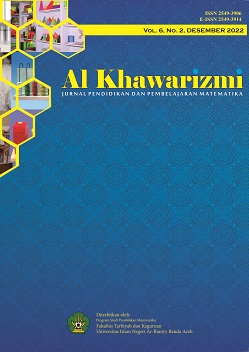Description of Procedural Fluency and Productive Mathematical Disposition of Middle School Students
DOI:
https://doi.org/10.22373/jppm.v7i1.18877Keywords:
Procedural Fluency, Productive DispositionAbstract
The objectives of this study to describe the level of procedural mathematical fluency of students in solving problems on number pattern material and to describe the level of students' mathematical productive disposition in class VIII SMP Negeri 1 Baitussalam. This study used descriptive qualitative research with three students as subjects grouped into three categories namely high, medium and low. The results showed that mathematical procedural fluency (1) students in the high level category fulfilled all indicators. (2) students in the moderate level category fulfill two of the three indicators. (3) students in the low level category only meet one indicator. And the results for mathematical productive dispositions: (1) students with a high level fulfill all indicators (2) students in the medium level category fulfill five of the seven indicators (3) students in the low level category only fulfill two of the seven indicators.References
Aprianti, R. (2014). Kelancaran Prosedur Matematis Siswa dalam Materi Operasi Hitung Pecahan di SMP. Jurnal Pendidikan dan Pembelajaran, vol. 3 no. 4. 3.
Darwani, Zubainur, & Saminan. (2020). Adaptive Reasioning and Strategic Competence Through Problem Based Learning in Middle School. Journal of Physics, Conference Series. 1460
Hamid, H., Angkotasan, N., Jalal, A., Muhtadi, D., & Sukirwan. (2020). Students’ mathematical proficiency in solving calculus problems after Maple implementation. Journal of Physics: Conference Series, 1613(1). https://doi.org/10.1088/1742-6596/1613/1/012025.
Haryandika, Uray Windi. (2017). Analisis Kelancaran Prosedural Matematis Siswa pada Materi Persamaan Eksponen Kelas X SMA Negeri 2 Singkawang, Jurnal Pendidikan Matematika Indonesia, vol. 2, no. 2. 72-77.
Hudiono, B. (2003). Penilaian Hasil Belajar Matematika. Pontianak: FKIP UNTAN.
Huzaimy, Arsety Ambar Suryani. (2019) Analisis Pengetahuan Prosedural Siswa dalam Menyelesaikan Soal Matematika ditinjau dari Gaya Berpikir Materi Sistem Persamaan Linear Dua Variabel Kelas VIII di SMP Negeri 1 Kalidawir. Skripsi, Tulungagung: Institut Agama Islam Negeri Tulungagung,
Isfanly F Rahman, dkk. (2018). Analisis Pemahaman Konseptual dan Kemampuan Prosedural Matematika Ditinjau Dari Tipe Kepribadian Siswa di SMP Negeri 1 Pinogaluman. Jurnal Riset dan Pengembangan Ilmu Pengetahuan. vol 3, no. 8.
Junpeng, P., Marwiang, M., Chiajunthuk, S., Suwannatrai, P., Chanayota, K., Pongboriboon, K., Tang, K. N., & Wilson, M. (2020). Validation of a digital tool for diagnosing mathematical proficiency. International Journal of Evaluation and Research in Education, 9(3), 665–674. https://doi.org/10.11591/ijere.v9i3.20503.
Kilpatrick, Jeremy. Jane Swafford dan Bradford Findell, (2001). Adding It Up: Helping Children Learn Mathematics. Washington, DC: National Academy Press.
Muslim, Audra P. (2018). Penerapan Tapps Disertai Hypnoteaching (Hypno-Tapps) Dalam Meningkatkan Disposisi Matematis Siswa SMP, vol. 4, no.1. 3.
Pratidiana, Deni dan Nunung Muhayatun. (2021). Analisis Kelancaran Prosedural Matematis Siswa dalam Menyelesaikan Soal Program Linear. Jurnal Ilmiah Pendidikan Matematika, vol 9, no. 2. 199.
Permendikbud No. 21, Tahun 2016
Sari, Novita. Edy Yusmin dan Asep Nursangaji. (2018). Kelancaran Prosedural Siswa dalam Menyelesaikan Soal Persamaan Kuadrat di Kelas X SMKN 2 Pontianak. Jurnal Pendidikan dan Pembelajaran, vol. 8, no. 2, 3.
Shodikin, A. (2018). Strategi Abduktif-Deduktif pada Pembelajaran Matematika dalam Peningkatan Disposisi Siswa. Jurnal Pendidikan Dan Pembelajaran Dasar, vol. 7, no. 2. 182-183.
Siegfried, J. M. (2012). The hidden strand of mathematical proficiency: defining and assessing for productive disposition in elementary school teachers mathematical content knowledge. San Diego.
Sugiyono. (2017). Metode Penelitian Kuantitatif, Kualitatif, dan R&D. Bandung: Alfabeta,.
Trisnowali, A. (2015). Profil Disposisi Matematika Siswa Pemenang Olimpiade pada Tingkat Provinsi Sulawesi Selatan, Journal of EST, vol. 1, no. 3. 48.
Watson, A. & Sullivan, P. A., (2008). Teachers Learning About Tasks and Lesson. Netherlands: Sense Publisher.

